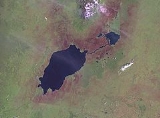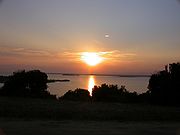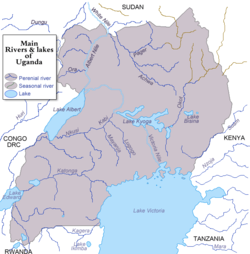
Lake Edward
Encyclopedia
Lake Edward or Edward Nyanza is the smallest of the African Great Lakes
. It is located in the western Great Rift Valley
, on the border between the Democratic Republic of the Congo
and Uganda
, with its northern shore a few kilometres south of the Equator
. The lake was named by the explorer Henry Morton Stanley
in honour of Prince Albert Edward, The Prince of Wales
, later to become King Edward VII.
 Stanley first saw the lake in 1875, and thinking it was part of Lake Albert, named it Beatrice Gulf. On his second visit in 1888 through 1889, he realized that there were two independent lakes, and gave it its current name. In 1973, Uganda and Zaire
Stanley first saw the lake in 1875, and thinking it was part of Lake Albert, named it Beatrice Gulf. On his second visit in 1888 through 1889, he realized that there were two independent lakes, and gave it its current name. In 1973, Uganda and Zaire
(Democratic Republic of the Congo) renamed it Lake Idi Amin or Lake Idi Amin Dada after Ugandan dictator Idi Amin
. After his overthrow in 1979, the name was changed back to Lake Edward.
into Lake Albert. Lake George
to the northeast empties into Lake Edward via the Kazinga Channel
.
The western escarpment
of the Great Rift Valley towers up to 2000 m above the western shore of the lake. The southern and eastern shores are flat lava
plains. The Ruwenzori Mountains lie 20 km north of the lake.
lies 80 km south, but its lava flows have reached the lake in the past.
The Katwe-Kikorongo field features dozens of large craters and cones covering an area of 30 km by 15 km between lakes Edward and George, and includes seven crater lakes. The largest of these, the 2.5-kilometre-long Lake Katwe, occupies a crater 4 km across and is separated from Lake Edward by just 300 m of land. The crater is about 100 m deep, and Lake Katwe's surface is about 40 m lower than Lake Edward's. It is remarkable that the volcanic origin of this area south-east of the Ruwenzoris was not known until reported by G. F. Scott Elliot in 1894. Stanley visited Lake Katwe in 1889 and noted the deep depression, the salinity of the lake, and a spring of sulphurous water nearby, but failed to connect this to volcanism.
The similarly-sized Bunyaruguru field on the other side of the Kazinga Channel contains about 30 crater lakes, some larger than Katwe.
(Congo) and the Queen Elizabeth National Park
(Uganda) and does not have extensive human habitation on its shores, except at Ishango
(DRC) in the north, home to a park ranger training facility. About two-thirds of its waters are in the DR Congo and one third in Uganda. Apart from Ishango, the main Congolese settlement in the south is Vitshumbi, while the Ugandan settlements are Mweya and Katwe in the north-east, near the crater lake of that name, which is the chief producer of salt for Uganda. The Mweya Safari Lodge is the main tourist facility, serving both Lake Edward and Lake Katwe. The nearest cities are Kasese
in Uganda to the north-east and Butembo
in DR Congo, to the north-west, which are respectively about 50 km and 150 km distant by road.
 Lake Edward is home to many species of fish, including populations of Bagrus docmac, Sarotherodon niloticus, Sarotherodon leucostictus, and over 50 species of Haplochromis
Lake Edward is home to many species of fish, including populations of Bagrus docmac, Sarotherodon niloticus, Sarotherodon leucostictus, and over 50 species of Haplochromis
and other haplochromine
species, of which only 8 are formally described. Fishing is an important activity among local residents. Fauna living on the banks of the lake – including chimpanzees, elephants, crocodiles, and lions – are protected by the national parks. The area is also home to many perennial and migratory bird species.
African Great Lakes
The African Great Lakes are a series of lakes and the Rift Valley lakes in and around the geographic Great Rift Valley formed by the action of the tectonic East African Rift on the continent of Africa...
. It is located in the western Great Rift Valley
Great Rift Valley
The Great Rift Valley is a name given in the late 19th century by British explorer John Walter Gregory to the continuous geographic trench, approximately in length, that runs from northern Syria in Southwest Asia to central Mozambique in South East Africa...
, on the border between the Democratic Republic of the Congo
Democratic Republic of the Congo
The Democratic Republic of the Congo is a state located in Central Africa. It is the second largest country in Africa by area and the eleventh largest in the world...
and Uganda
Uganda
Uganda , officially the Republic of Uganda, is a landlocked country in East Africa. Uganda is also known as the "Pearl of Africa". It is bordered on the east by Kenya, on the north by South Sudan, on the west by the Democratic Republic of the Congo, on the southwest by Rwanda, and on the south by...
, with its northern shore a few kilometres south of the Equator
Equator
An equator is the intersection of a sphere's surface with the plane perpendicular to the sphere's axis of rotation and containing the sphere's center of mass....
. The lake was named by the explorer Henry Morton Stanley
Henry Morton Stanley
Sir Henry Morton Stanley, GCB, born John Rowlands , was a Welsh journalist and explorer famous for his exploration of Africa and his search for David Livingstone. Upon finding Livingstone, Stanley allegedly uttered the now-famous greeting, "Dr...
in honour of Prince Albert Edward, The Prince of Wales
Edward VII of the United Kingdom
Edward VII was King of the United Kingdom and the British Dominions and Emperor of India from 22 January 1901 until his death in 1910...
, later to become King Edward VII.
History

Zaire
The Republic of Zaire was the name of the present Democratic Republic of the Congo between 27 October 1971 and 17 May 1997. The name of Zaire derives from the , itself an adaptation of the Kongo word nzere or nzadi, or "the river that swallows all rivers".-Self-proclaimed Father of the Nation:In...
(Democratic Republic of the Congo) renamed it Lake Idi Amin or Lake Idi Amin Dada after Ugandan dictator Idi Amin
Idi Amin
Idi Amin Dada was a military leader and President of Uganda from 1971 to 1979. Amin joined the British colonial regiment, the King's African Rifles in 1946. Eventually he held the rank of Major General in the post-colonial Ugandan Army and became its Commander before seizing power in the military...
. After his overthrow in 1979, the name was changed back to Lake Edward.
Topography and drainage
Lake Edward lies at an elevation of 920 metres, is 77 km long by 40 km wide at its maximum points, and covers a total surface area of 2325 km² (897.7 sq mi), making it the 15th-largest on the continent. The lake is fed by the Nyamugasani River, the Ishasha River, the Rutshuru River, the Ntungwe River and the Rwindi River. It empties to the north via the Semliki RiverSemliki River
Semliki River is a major river in Central Africa. It flows northwards from Lake Edward in the Democratic Republic of the Congo, across the Uganda border, through western Uganda in Bundibugyo District, near the Semuliki National Park. It empties into Lake Albert at...
into Lake Albert. Lake George
Lake George (Uganda)
Lake George or Lake Dweru is a lake in Uganda. It covers a total surface area of 250 km² and is a part of Africa's Great Lakes system but is not itself considered one of the Great Lakes. Like the other lakes in the region it was named after a member of the British royal family, in this case...
to the northeast empties into Lake Edward via the Kazinga Channel
Kazinga Channel
The Kazinga Channel in Uganda is a wide, 32 km long natural channel that links Lake Edward and Lake George, and a dominant feature of Queen Elizabeth National Park...
.
The western escarpment
Escarpment
An escarpment is a steep slope or long cliff that occurs from erosion or faulting and separates two relatively level areas of differing elevations.-Description and variants:...
of the Great Rift Valley towers up to 2000 m above the western shore of the lake. The southern and eastern shores are flat lava
Lava
Lava refers both to molten rock expelled by a volcano during an eruption and the resulting rock after solidification and cooling. This molten rock is formed in the interior of some planets, including Earth, and some of their satellites. When first erupted from a volcanic vent, lava is a liquid at...
plains. The Ruwenzori Mountains lie 20 km north of the lake.
Volcanism
The region shows much evidence of volcanic activity in the last 5000 years. The Katwe-Kikorongo and Bunyaruguru Volcanic Fields, with extensive cones and craters, lie either side of the Kazinga Channel on the north-west shore of the lake. It is thought that Lakes George and Edward have been joined as one larger lake in the past, but lava from these fields flowed in and divided it, leaving only the Kazinga Channel as the remnant of the past union. To the south, the May-ya-Moto thermally active volcano lies 30 km away, and the Nyamuragira volcano in the western Virunga MountainsVirunga Mountains
The Virunga Mountains are a chain of volcanoes in East Africa, along the northern border of Rwanda, the Democratic Republic of the Congo and Uganda. The mountain range is a branch of the Albertine Rift, a part of the Great Rift Valley. They are located between Lake Edward and Lake Kivu...
lies 80 km south, but its lava flows have reached the lake in the past.
The Katwe-Kikorongo field features dozens of large craters and cones covering an area of 30 km by 15 km between lakes Edward and George, and includes seven crater lakes. The largest of these, the 2.5-kilometre-long Lake Katwe, occupies a crater 4 km across and is separated from Lake Edward by just 300 m of land. The crater is about 100 m deep, and Lake Katwe's surface is about 40 m lower than Lake Edward's. It is remarkable that the volcanic origin of this area south-east of the Ruwenzoris was not known until reported by G. F. Scott Elliot in 1894. Stanley visited Lake Katwe in 1889 and noted the deep depression, the salinity of the lake, and a spring of sulphurous water nearby, but failed to connect this to volcanism.
The similarly-sized Bunyaruguru field on the other side of the Kazinga Channel contains about 30 crater lakes, some larger than Katwe.
Settlements
Lake Edward lies completely within the Virunga National ParkVirunga National Park
The Virunga National Park , formerly named Albert National Park, is a 7800 square km National Park that stretches from the Virunga Mountains in the South, to the Rwenzori Mountains in the North, in the eastern Democratic Republic of Congo, bordering Volcanoes National Park in Rwanda and Rwenzori...
(Congo) and the Queen Elizabeth National Park
Queen Elizabeth National Park
-Location:The national park is located in western Uganda, spanning the districts of Kasese, Kamwenge, Bushenyi and Rukungiri. Its location is approximately , by road, southwest of Kampala, Uganda's capital and largest city. The town of Kasese lies just outside the northeastern edge of the park,...
(Uganda) and does not have extensive human habitation on its shores, except at Ishango
Ishango
Ishango is a sub-station of Virunga National Park, situated on the Northern Shores of Lake Edward in the Democratic Republic of the Congo. The station was created in the 1950s and is famous for many reasons:...
(DRC) in the north, home to a park ranger training facility. About two-thirds of its waters are in the DR Congo and one third in Uganda. Apart from Ishango, the main Congolese settlement in the south is Vitshumbi, while the Ugandan settlements are Mweya and Katwe in the north-east, near the crater lake of that name, which is the chief producer of salt for Uganda. The Mweya Safari Lodge is the main tourist facility, serving both Lake Edward and Lake Katwe. The nearest cities are Kasese
Kasese
Kasese is a town in Western Uganda, lying north of Lake George. It originally grew around the copper mine at Kilembe, while attention later turned to cobalt mining. It is the 'chief town' of Kasese District and the district headquarters are located there...
in Uganda to the north-east and Butembo
Butembo
Butembo is a city in North Kivu, in the north eastern Democratic Republic of Congo, lying west of the Virunga National Park. Until the Congo Civil War, it was an important commercial centre with a large market, a cathedral, a small hospital, and an airport, lying in an area known for tea and...
in DR Congo, to the north-west, which are respectively about 50 km and 150 km distant by road.
Ecology

Haplochromis
Haplochromis is a ray-finned fish genus in the family Cichlidae. It has been used as the default "wastebin taxon" for Pseudocrenilabrinae cichlids of the East African Rift, and as such became the "largest" fish "genus"...
and other haplochromine
Haplochromine
The haplochromine cichlids are a tribe of cichlids in subfamily Pseudocrenilabrinae called Haplochromini. This group includes the type genus plus a number of closely related genera such as Aulonocara, Astatotilapia, and Chilotilapia. They are endemic to eastern and southern Africa...
species, of which only 8 are formally described. Fishing is an important activity among local residents. Fauna living on the banks of the lake – including chimpanzees, elephants, crocodiles, and lions – are protected by the national parks. The area is also home to many perennial and migratory bird species.

